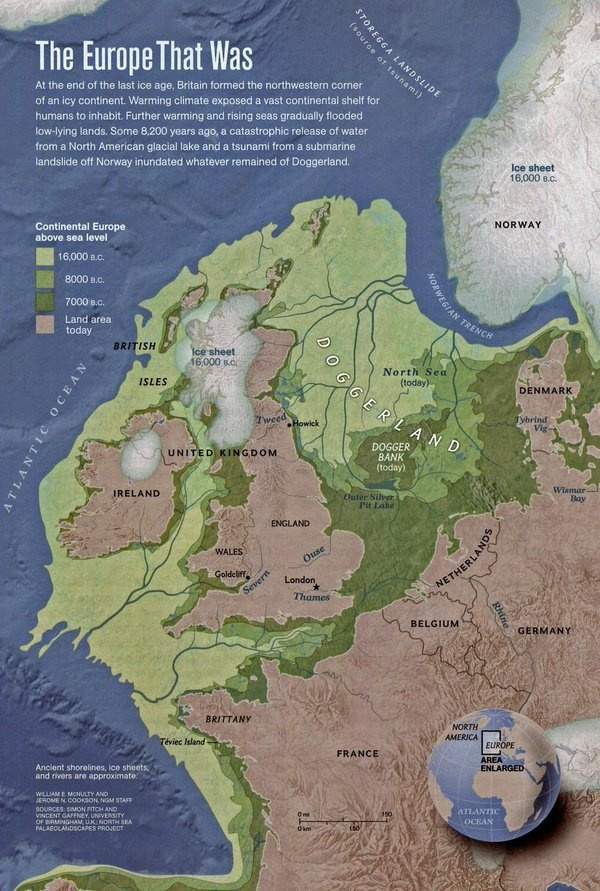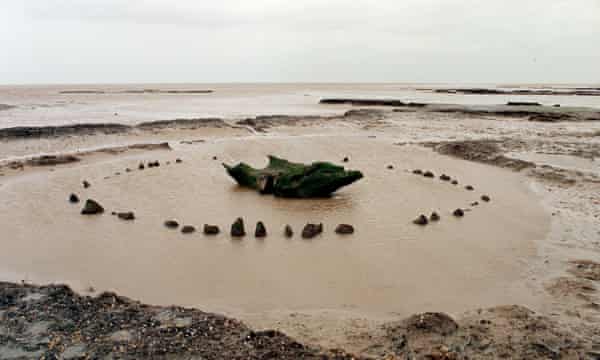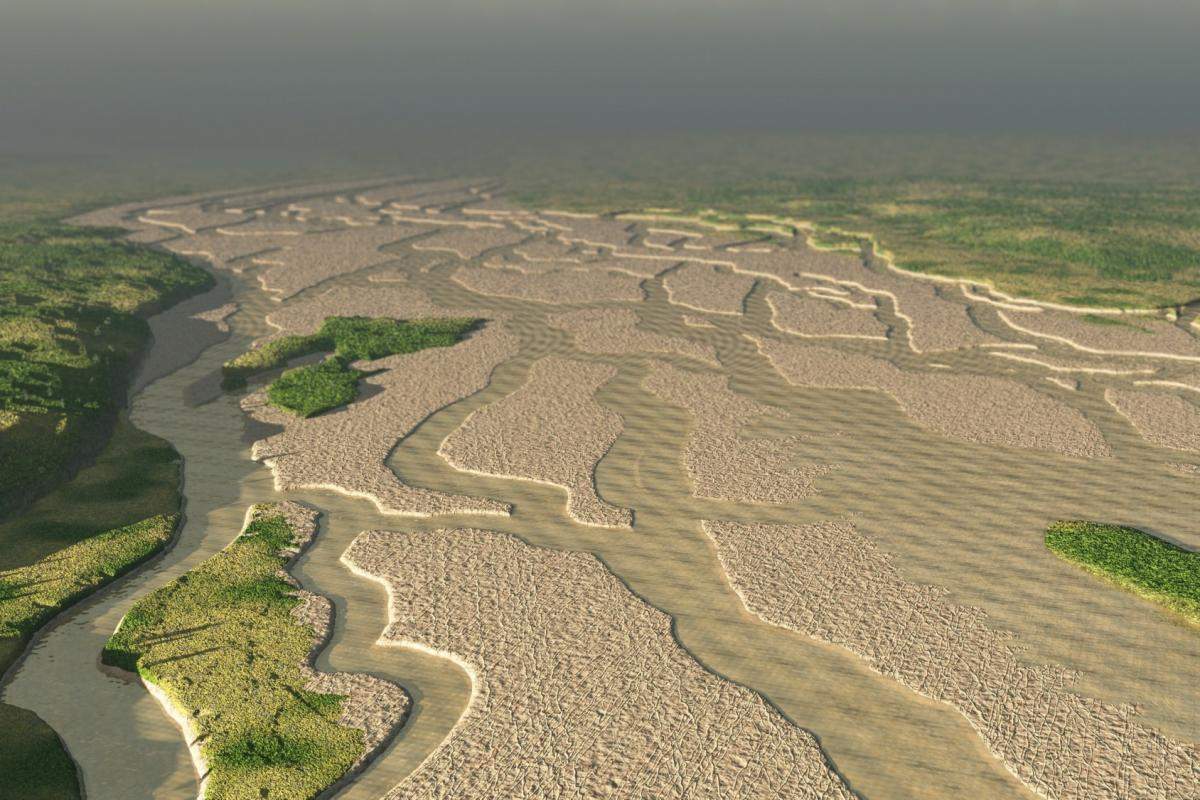One of my favorite podcasts is the In Our Time BBC podcast. It’s Melvyn Bragg questioning a truly amazing collection of experts on a very wide range of topics, and having tea.
I had some driving to do this weekend and listened to an episode that made my mind whirl a lot: doggerland. [bbc] “It’s about Dogger Bank, I assume” – the shallow area in the North Sea where a preliminary engagement to the great WWI naval battle at Jutland was fought. Yes, and no. I didn’t realize that before the oceans rose after the last ice age ended, there was a whole civilization down there, 7,000+ years ago.

They experienced the sort of thing we’re in for, with slowly rising water (“slow”, in this usage, means “over the course of about 100 years”) – at one point people could walk from what is now Norway to Aberdeen in Scotland. My brain does not do a good job with deep time concepts, so my first assumption was that it was a brief opportunity, a “land bridge” but in fact the area was dry and very fertile for thousands of years, and hosted a lively civilization. Talk about “Atlantis”! What is now the North Sea was a flat expanse which probably resembled Florida today [topologically, not climate]
As oil and gas exploration exploited the North Sea, tremendously detailed surface maps were produced of what is the bottom of the sea, today, but people have been occasionally dredging up ancient artifacts for a long time. I had no idea. There are houses down there, too, or what’s left of them. And other things people made. This lovely carving appears to be someone wearing some kind of armor:

I recall hearing that there were once mammoths and hippoes in England but I didn’t realize that their remains sometimes come up on the end of a dredge. What a thing that must have been for various fishermen, over time, to pull up an elephant skull.
The bog oak that I use for knife handles is from the same time-period, but from Ukraine. I assume that forests used to stand where the Pripet marshes are, now, the trees got buried with the peat moss, and saturated with the tannins in the oak and peat. The coast near Norfolk has a few places where doggerland artifacts and traces of the people are still visible, including the famous petrified footsteps of a 7000+ year-old family. And there are spots where people either planted trees as structural elements, or for ceremonial purposes.

[source]

A bit more about doggerland is [here]
Doggerland is going to wind up under deeper water, still – Doggerland is covered in about a half a mile of water (1 km) [see comments: I got that horribly wrong] so it’s going to be just a bit deeper than Florida and New York City.
And the wheel keeps turning.

Half a mile? Wikipedia differs.
Lofty@#1:
Did I get some “off the cuff” wrong? Ugh, very. I believe I confused meters for feet, or something. More like 2 miles?
Interesting how that appears to have happened in my mind. I made the estimate/calculation and thought “well if sailors called it the dogger bank then it must be detectable with a lead line or otherwise a hazard to navigation so 1/2 mile seems to work.” Also I know that there are oil rigs and drilling and I don’t think that’s possible in abyssal depths.
That’s all irrelevant to anything but it shows me, I suppose, how confirmation bias feels. “That seems about right…”
The recent work that has been done on mapping the routes of prehistoric rivers in Doggerland, and working out how and when it got flooded is fascinating. Well the whole area of study is fascinating and so cool.
I wasn’t sure this made sense — it was temperate, not subtropical — until I realized you meant the flat, marshy, often waterlogged geography (during the late spring to early fall) rather than the climate.
Dogger Bank is only between 15 and 36 metres deep (50 to 120 ft) – well within the range of regular SCUBA divers. The average depth of the North Sea is 95m (312 ft). So no, not “about a half a mile of water (1 km)” and definitely not “more like 2 miles”. It’s barely more than a deep puddle. (For reference, 1 km = 0.62 miles, or 0.54 nautical miles.)
A better analogy would probably be that Doggerland resembled what the Netherlands would look like without dikes, canals, and other water drainage and mitigation systems.
Owlmirror@#4:
I wasn’t sure this made sense — it was temperate, not subtropical — until I realized you meant the flat, marshy, often waterlogged geography (during the late spring to early fall) rather than the climate.
You are correct, I was thinking about topography not climate.
Dunc@#5:
It’s barely more than a deep puddle.
Arrgh, I am really striking out on this one.
Thank you.
I think I see the problem: I googled “depth of North Atlantic” not “depth of North Sea“. When my dogs made a mistake this bad, they’d crawl under the couch and pretend to be invisible (which was funny because that meant the couch was rocking on the dog’s back – they were big boys) I’m not sure what I should do when I make a mistake this bad but the couch is looking mighty appealing – there’s a nice cool dark hidey hole under it…
What is now the North Sea was a flat expanse which probably resembled Florida today
Probably with less and fewer cocaine, discos, and mass shootings.
I wondered about the hippos, but Hippopotamus antiquus did make it as far as the British Isles.
Fascinating podcast. I had no idea either that the land was that extensive nor that it was settled. I always thought of it as something in the Channel at most.
How do you define “abyssal”? There are drilling ships that have spudded new wells in water depths of around 2 miles. I think the record is 2.1 miles (3400 m), but that may have been broken by now.
So many podcasts, so little time: I’m currently listening my way through 13 Minutes to the Moon:
https://www.bbc.co.uk/programmes/w13xttx2/episodes/downloads
Sunday Afternoon@#13:
13 Minutes to the Moon
I need to binge on that one when it’s done. It sounds awesome.
Probably should do a “best podcasts” and “best podcast episodes” thread.
ridana@#12:
How do you define “abyssal”?
I didn’t – but I was thinking “over the deep trenches” – I think the Mariana is something like 5 miles down. And I remember that the K-129 sunk in 3 miles of water in the Pacific, and that was some crazy “edge engineering” – I didn’t realize they could drill as deep as 2 miles; I thought the limit was continental shelf depth. I guess I’m showing my age.